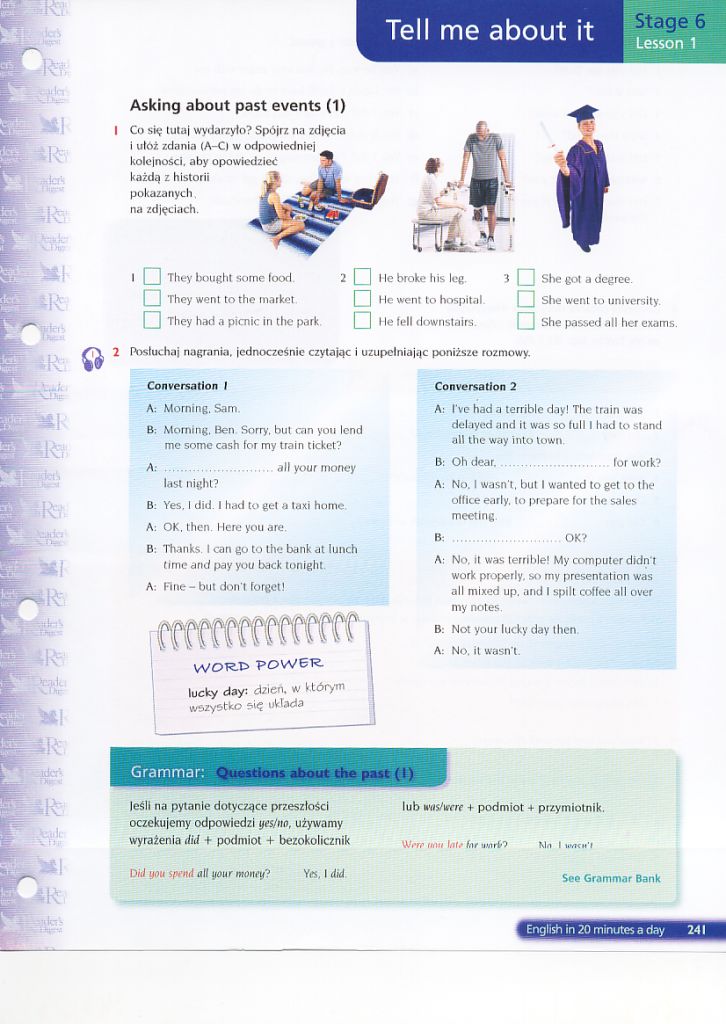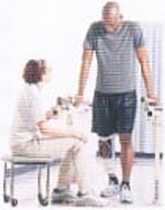47662 SAVE0318




Asking about past events (1)

Co się tutaj wydarzyło? Spójrz na zdjęcia i ułóż zdania (A-C) w odpowiedniej kolejności, aby opowiedzieć każdą z historii pokazanych na zdjęciach.
They bought sotnr lood □ They went to thc market ] They had a pienie in thc park
□
□
2 [^~] I le broke his leg ] I le went to hospital |_l He fell downstairs
She got a degree.
She went to university. She passed all her cxams.
2 PV>słuchaj nagrania, jednocześnie czytając i uzupełniając poniższe rozmowy.
Conversation I
Convcrsation 2
A: Morning. Sam
B: Moming. Ben Sorry, but can you lend me some cash for my train ticket?
A: ...........all your money
last nighl?
B: Yes. I did. I had to get a taxi homc
A: OK. then. I łere you are.
B Thanks I can go to the bank at lunch time and pay you back toniglit
A: Fine-but lon t forget!

POW6R
A: l ve had a terrible day! The train was delayed and it was so łull I had to stand all the way into town
B: Oh dear. .............. fot work?
A: No. I waśn i, but I wanted to get to the Office early. to preparc for the sales meeting
B: ....................... OK?
A: N-». it was terrible! My Computer didn t work properly. so my presentation was all mixed up. and I spili coffee all over my notes.
B: Not youi lucky day then
A: No. it waśni.
lucky day: dzień. .v i Lór .m
wszystko układa

jeśli na pytanie dotyczące przeszłości oczekujemy odpowiedzi yes/ito, używamy wyrażenia did + podmiot + bezokolicznik lub Mi$/\rcre + podmiot + przymiotnik.
(/ii;/ l.if,- fnr u.virt>'? Mn I uvxn'i
DW you sp <td all your money?
Yes, I did
See Grammar Bank
Wyszukiwarka
Podobne podstrony:
SAVE0318 iTell me about itLesson 1Asking about past events (1) Co się tutaj wydarzyło? Spójrz na zdj
SAVE0322 iTell me about itLesson 3What were they doing? Posłuchaj nabrania Gdzie znajdowały się wymi
SAVE0322 iTell me about itLesson 3What were they doing? Posłuchaj nabrania Gdzie znajdowały się wymi
50828 SAVE0322 iTell me about itLesson 3What were they doing? Posłuchaj nabrania Gdzie znajdowały si
19138 SAVE0317 LESSON 1 Asking about past events (1) Pytanie o wydarzenia z przeszłości (1) LESSON
SAVE0342 Tell me about itLesson 11Talking about futurę plans I Co lubisz robić w weekendy lub kiedy
SAVE0360 Tell me about itLesson 18Promises and resolutions 1 Czy podejmujesz posta
SAVE0336 Tell me about itLesson 8What s going to happen? 1 Spójrz na poniższe wyra
SAVE0350 Tell me about itLesson 13Talking about past events I Czy kiedykolwiek musiałeś zgłosić poli
SAVE0356 Tell me about itLesson 16Famous lives 1 Którą ze znanych osób podziwiasz?
więcej podobnych podstron